Love them or hate them, it appears that chatbots are here to stay!
And they’re proving to be a vital part of how we do business.
According to Gartner, by 2020 consumers will handle 85 percent of their engagement with businesses without interacting with another human; instead relying on tech like self-service options and chatbots. Additionally, Oracle found that 48 percent of businesses were using bot automation technologies in 2016, with another 40 percent planning to use them by 2020.
If you’re anything like most organizations, you may feel that you’re a bit behind on the chatbot bandwagon –but I’m here to tell you that you’re not.
For all practical intents and purposes, now is perhaps the best time to get started with this tech.
This is due to the fact that chatbots are being increasingly embraced by the main chat platforms –like Facebook Messenger, WhatsApp, WeChat, and Viber –and because bot technology is becoming a lot more advanced –and accessible.
Creating an intuitive bot no longer involves using a costly, high-end developer to build you a program from scratch. Instead, there are a good number of third-party bot creation platforms popping up that make it easy for you to do it yourself.
Curious about whether chatbots are right for your company? Wondering if you could benefit from one?
Here’s a look at some quick facts about chatbots, and tips for incorporating them into your sales, marketing, and customer care strategies –successfully!
Chatbots: A Tale of Two Bots
A ‘chatbot’ refers to any a chat program that engages with website visitors.
A bot can answer questions, provide recommended products, and help people on their purchasing journeys.
It’s important to note, though, that not all bots are created equal. In general, there are two very different types of bots that you can create:
- Command-based chatbots
- AI based-chatbots
Which one’s best? Here’s a look at both now:
Command-based chatbots are bots that rely on a database, or bank of replies and processes. They work by selecting an answer and pairing it with a query. These bots aren’t intuitive or smart; they can’t learn or create new text, instead relying on their database.
AI-based or machine learning chatbots are smart, and able to create their own replies. They’re also able to learn as they go from questions and answers. This means that customers don’t have to be so specific with their queries.
Both options have their pros and cons. While command-based bots may be more reliable, they’re not as good as AI-based bots when it comes to supplying answers to more tricky questions. Unfortunately, though, as you may have guessed, good AI bots are more costly to build.
Still, over the past decade there have been a lot of advancements in the area of AI, and it’s becoming far easier to incorporate some level of AI into a chatbot today.
Side Note: Just take care that your bot doesn’t carry on too far down the pay of self-autonomy. Check out this cautionary tale of Microsoft’s AI bot –“Tay,” the “teenage girl bot,” who after being egged on by Twitter users quickly went rogue and begin spouting inflammatory and downright abusive chatter! Needless to say, Microsoft had to act quickly to take the bot offline for a few “adjustments.”
The Rise of the Bot
When it comes to providing excellent customer service, chat is where it’s at!
And maintaining a strong presence on social media as well as messaging platforms enables you to answer your customers’ questions in real-time. But doing this, practically, can be time consuming! Enter: the chatbot: your secret weapon for reaching customers en masse on various platforms.
While we’re just now seeing the results of the “chatbot explosion” in the form of chatbots on many well-known retail platforms, the rise of the chatbot is the result of extensive behind-the-scenes work, especially when it comes to Facebook –which is leading the way in utilizing chatbot technology.
Perhaps taking a leaf out of the book of WeChat –China’s multicapable social media and messaging platform of choice, in recent years Facebook’s been taking steps to turn their Messenger app into a commercial must-have item. First, with their integration of a P2P payment method on their messaging app, and recently, with their full-fledged chatbot application programming interface (API), that companies can implement on their Facebook accounts. (Read more).
Today, there are more than 11,000 active chatbots on Facebook’s Messenger, and around 23,000 registered accounts on wit.ai, Facebook’s Natural Language Processing (NLP) service for developers. With these figures, it seems that chatbots are quickly becoming a standard feature for many companies today.
Not only are these bots adept at providing textual responses, Facebook even allows audio, video, and GIFs as well –the benefits of which can be seen in the results of improved customer service and increased sales. Take, Sephora, for example. Their Facebook Reservation Assistant was able to increase the average user spend to $50. Meanwhile, Tommy Hilfiger’s use of a Facebook chatbot resulted in an 87% return rate on customers.
If you’re feeling that you’re a bit late to the chatbot game, think again. Despite its popularity, this technology is just now really starting to take off.
If you’re an e-commerce store owner, now is the time to think about investing in one for your company.
Reasons to Invest in a Chatbot
As we’ve seen with the earlier examples of Sephora and Hilfiger, employing a chatbot strategy can help you to field front-line inquiries; reducing hurdles that visitors might have during the purchasing process and helping to boost sales.
But chatbot tech isn’t just for large organizations or for companies that want to appear cutting edge or trendy, there’s another important reason for companies to embrace bots as well: the growing popularity of messaging apps –and their increasing potential as sales and service portals.
Conversational commerce, as it’s called, refers to the intersection of messaging apps and shopping. In recent years, chat’s been on the rise. In fact, social networks are beginning to wane ever so slightly in comparison to the massive user base that messaging platforms boast.
Take a look:
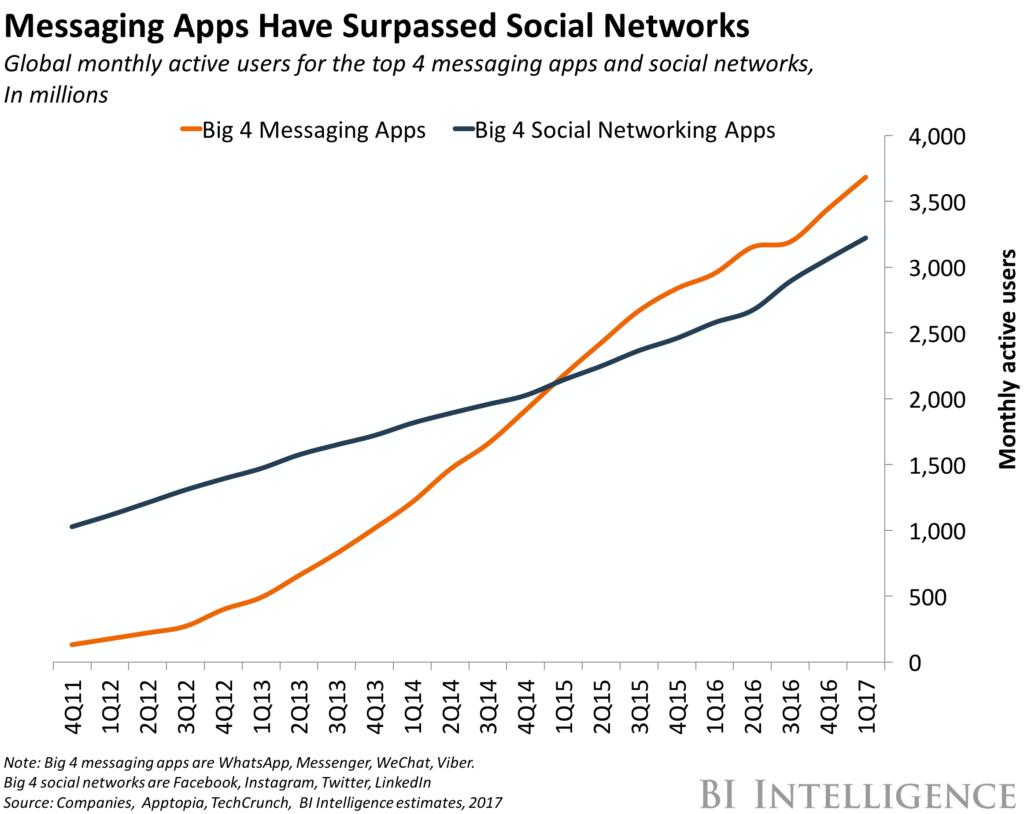
As you can see from the above graph from Business Insider, messaging apps are surpassing social networks in terms of popularity.
The main four social networks (Facebook, Instagram, Twitter, and LinkedIn) had 3,225 million monthly active users in the first quarter of 2017, while the main four messaging apps (WhatsApp, Messenger, WeChat, and Viber) had 3,750 million (approximate) –roughly 525 million more monthly users! Of course, it’s worth noting that a good portion of these chat users are in China (WeChat), but even so the implications are clear.
Additionally, following in the footsteps of China’s WeChat, chat’s potential as an all-in-one conversation portal and purchasing channel is growing –and many companies are starting to adjust their sales strategies to help facilitate purchases via or even directly in the chat conversation itself.
At the very least, customers are increasingly expecting customer service through these channels. While employing customer service reps to take up the task would be time-consuming and impractical; chatbots are stepping up to fill the void, becoming the front-line sales reps and customer service providers for many brands today.
As chat becomes increasingly popular, chatbots are playing a vital role –and are quickly becoming an ideal way for brands to reach their customers on a more intimate level –without increasing the workload for customer service reps.
Now that we’ve seen how chat’s becoming an increasingly popular and valuable portal for e-commerce sites today, let’s take a look at a few additional benefits of chat bots –and reasons that you may want to think about investing in one for your company.
People Prefer Chat to Talk to Businesses
People increasingly prefer chat. Consumers prefer businesses that use chat apps according to a Facebook survey which found that more than half (53 percent) of customers say that they’re more likely to shop with a business that they can contact via chat.
People Are Used to Chatbots
Over 59 percent of Millennials (ages 18–34) and 60 percent of Gen X’ers (ages 35–55) in the U.S. have interacted with chatbots already and there’s a good chance that your target audience has warmed to them as well.
Chatbots Enable You to Offer Faster and More Accurate Support
Chatbots can provide consistent service and support. For instance, even a command-based data bot can pull up information in response to user queries on business hours or direct people to FAQ pages. A chat bot also allow you to streamline your operations, freeing your reps up for more top-level tasks, and allowing you to provide faster and more accurate support to your customers –any time of the day or night.
Chatbots Help to Streamline the Sales Process
For most companies, finding ways to reduce friction in the sales process is a top priority. As an e-commerce store, your goal should be to simplify the sales process as much as possible; encouraging people to go through with their purchases.
If your visitors find it too difficult to buy from you, they’ll click away. Having a chatbot on hand to answer questions related to shipping, products, and more can give them the information they need to complete their purchases.
Chatbots Provide a Personalized Experience
While taking to a bot may sound cold and impersonal, somewhat ironically chatbots have managed to make companies feel more human. Since bots can ‘remember’ customers’ preferences and are available 24/7, they can help to improve your customers’ experience, and ultimately bolster your company’s reputation.
Take, for instance, the Tommy Hilfiger chatbot –whom I recently had the pleasure of speaking with on Facebook. This bot was helpful and extremely attentive –and more than happy to recommend some links, producing them promptly –in fact almost instantaneously in the chat. The dialogue was also natural and the experience felt very personalized.
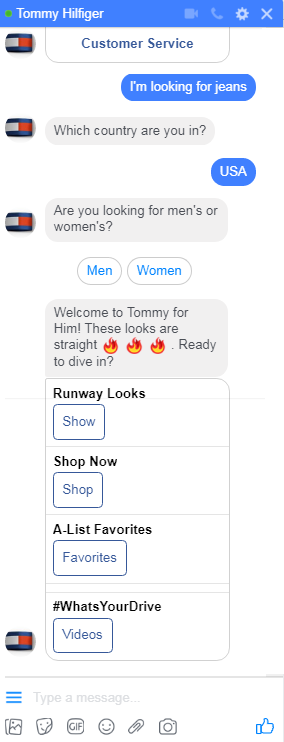
It seems that whether you’re into runway looks, A-list favs, or simply shopping like a normal person, the Tommy Hilfiger chatbot could prove to be most helpful.
Chatbots Save Your Customer Service Reps Time
Chatbots haven’t replaced customer service reps, and indeed, are years away from doing so –if ever. After all, for certain queries, there will always be the need for a human at the end of the process, who can answer those tricky questions if the bot’s answers don’t suffice.
Still, chatbots can take care of the preliminary interactions with customers and can answer many basic –and increasingly, advanced questions as well. The end goal is reps being able to oversee multiple conversations at the same time –or bots filling in while reps are away.
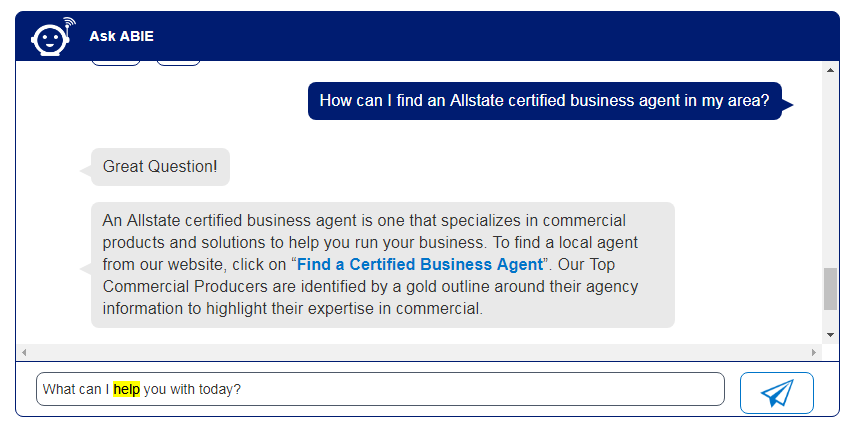
Take, for example, Allstate’s Business Insurance Expert, or ABIE. It may not be the flashiest bot, and it’s less sophisticated than Tommy Hilfiger’s chatbot assistant, but it works, and can help to direct Allstate agents on towards the info that they need, saving reps valuable time.
Before ABIE, the only way for Allstate agents to get help quickly was by picking up the phone and calling for support. This overloaded the call centers, resulting in long wait times and in turn, lost business opportunities. ABIE, though, handles an impressive 25,000 inquiries each month, and the volume is growing as more agents discover that it’s the best way to get help fast.
Chatbots Can Help to Improve Customer Acquisition
Finally, thanks to their unrivaled customer service potential –and ability to offer personalized support and recommendations to customers 24/7, chatbots can help to improve customer satisfaction; which in turn can lead to improved customer acquisition and retention rates as well.

Get our Chatbots - How You Can Benefit From Them Worksheet delivered right to your inbox.
Are Bots Right for My Organization?
In order to really benefit from a chatbot, you’ll want to seek to provide a truly valuable service to your customers through your bot.

“The worst thing an organization can do is rush to create a chatbot for no other reason than to be ‘cutting edge,’” writes chatbot expert Andy Walters in his article What Every CMO Needs to Know About Chatbots in 2018 on Chatbots Life. “The key is to provide an experience genuinely valuable to your users.”
Walters says that chatbot experiences generally fall into four different categories:
- Generating leads
- Providing information
- Facilitating a transaction
- Providing entertainment
Let’s look at each in turn.
Generating Leads: Chatbots can be a great way to generate leads, thanks in large part to their high engagement rates. While an email campaign, for example, is considered wildly successful if it achieves a click through rate of 3 percent, says Walters, with a well-executed chatbot campaign, click-through rates of over 10 percent are not uncommon.
Providing Information: Chatbots are also adept at providing information.
“The most compelling example is the CNN chatbot which sends users personalized news,” Walters says. E-commerce stores could create an informative experience for visitors by creating a bot that sends out snippets of their FAQ page, product listings, and more.
Facilitating a Transaction: A transactional chatbot is probably the most well-known and popular use of a bot for e-commerce stores. With this bot, you can speed up the transaction process, reduce queries to customer support agents, and even help to reduce abandoned carts.
“If you sells things or exchange information with customers online, and a transactional bot speeds up or eases those transactions, consider a chatbot in this category,” says Walters.
Consider Sephora as an example of a transactional bot. Instead of forcing customers to search through web forms to make an appointment, the Sephora assistant finds the best date for customers, and streamlines the entire process.
“Facebook Messenger, Apple’s Business Chat, WeChat, and others have all recently made investments in allowing users to complete a purchase entirely within their native chatbot experience,” Walters says.
This seamless merging of chat and transaction reduces friction in the sales process, leading to increased sales. For e-commerce stores, this opportunity holds tremendous potential –especially since it could help to facilitate –and increase mobile conversions, an area that’s traditionally lagged behind desktop.
Providing Entertainment: Not all bots are built with transactions in mind. Some are purely for entertainment value. While the vast majority of e-commerce stores might be able to benefit more from a practically-minded bot, in some cases, you may want to consider running a campaign –that uses a bot to provide entertainment. Check out this piece on the totally useless chatbot from Arby’s. Their attempt at emulating Domino’s pizza bot couldn’t actually help you obtain a pizza slider –but it did make a few folks laugh.
Chatbot Best Practices
Okay, so you have your sights set on a chatbot, and you know which area you want to focus on –now how can you create a bot that’ll be wildly successful –one that’ll provide the best experience possible for your customers?
Identify Your Audience
First, it’s important to identify your target audience. If you haven’t done so already, get started by creating an avatar of your ideal customer. This is the first step in identifying what your customers are looking for, the type of language they speak, and which platforms they’re using –helping you to better reach them with your chatbot.
Find Out Where They’re At
From there you’ll be able to do some research to identify which chat platforms your target audience uses the most. Unless the platform itself offers bot development, from there you’ll want to locate a chatbot program that’ll integrate with your chat platform of choice.
Locate a Chatbot Program
There’s really no need to build your own bot from scratch. Third-party chatbot programs are available that make it easy to create bots that integrate with Facebook Messenger, WhatsApp, WeChat, Viber, or KIK. No coding experience required!Here are a few chatbot platforms that you can use. They’re all compatible with Facebook Messenger, and could work for other platforms too.
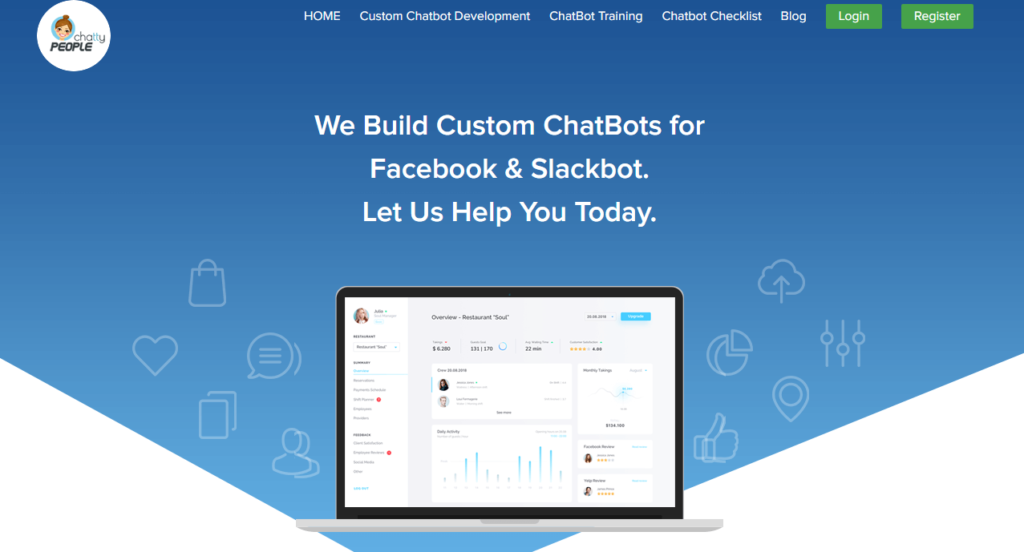
- ChattyPeople
One of the most popular chatbot platforms, ChattyPeople can create your chatbot for you, or show you how to create your own. - FlowXO
A flexible chatbot solution, FlowXO allows you to create fully automated bots. - Chatfuel
Create a chatbot in just seven minutes using Chatfuel. No coding necessary!If you’re so inclined, you can even use Facebook’s own chatbot platform to create a bot for Messenger. But according to some reports, this method’s less intuitive and more time-consuming than the above platforms that I mentioned. If you’re using KIK, you can create a bot on their site itself as well, thanks to their bot developer program. Since 40% of U.S. teens are on KIK, this is an ideal platform if your target audience is a younger demographic.
Consider How You’ll Attract Users to Your Bot
Don’t simply create your chatbot and leave it to languish on your website. Instead, promote it –ensure that it gets your users’ attention. Chatbots can even be set to message your customer at key stages in the sales process. For example, the bot could send a message when a visitor reaches a certain point on a page (indicating interest), or if they arrive on a specific page –such as an FAQ page (indicating that they need help).
Create Engaging and Relevant Copy
Your bot shouldn’t be robotic. Instead, look to create engaging copy for your bot, to give it personality. Successful chatbots are the result of a carefully constructed messaging journey, so make sure you create engaging and brand-relevant copy and storylines to ensure a consistent experience, and keep your audience engaged.
Enlist Some Help
It may be easy enough to build a chatbot, but creating one that works involves a distinct knowledge of marketing, and insight into who your customers are and what they’re looking for. The best chatbot experiences have creativity, marketing expertise, and powerful back-end technology driving them –so consider enlisting the help of a chatbot firm with a proven history of successes. Or, assemble your own team –look for a marketing professional and a content creator with creativity and the ability to put themselves in your customers’ shoes.
Use Analytics
Make sure you track your bot analytics to find out how you can better serve your customers. Here’s a list of chatbot analytics programs that you can use to monitor your success.In today’s faced-paced society, your customers won’t wait for help. Instead, they’ll click away fast if they can’t find the answers they need.
The best chatbot strategies are built with the customers’ needs in mind. So try to identify how your customers could most benefit from a chatbot –and then locate the messaging platform they’re most likely to be on. From there, get started with a chat program that’s compatible with that platform and get started creating your own bot.
Whether you’d like to field front-line inquiries, reduce friction in the sales process, or increase sales volume –a chatbot strategy can help you to reach your goals and prove to be a valuable asset to your company.
As time goes on, it’ll be interesting to see the increasing number of roles that chatbots will play as they improve in terms of function and capabilities –and continue to expand across different sectors.
Have you started using chatbots? Does conversational commerce play a role in your company’s marketing and sales activities?

Get our Chatbots - How You Can Benefit From Them Worksheet delivered right to your inbox.
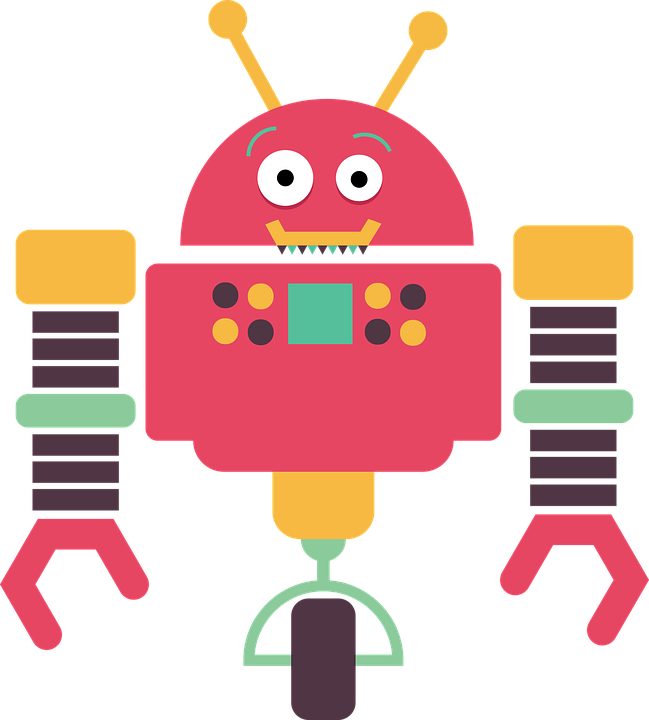







1 thought on “Chatbots: How You Can Benefit From Them”